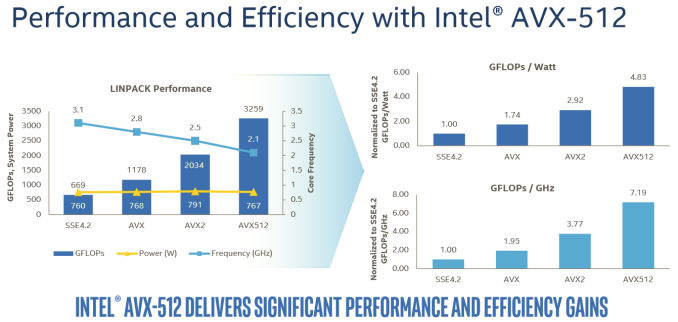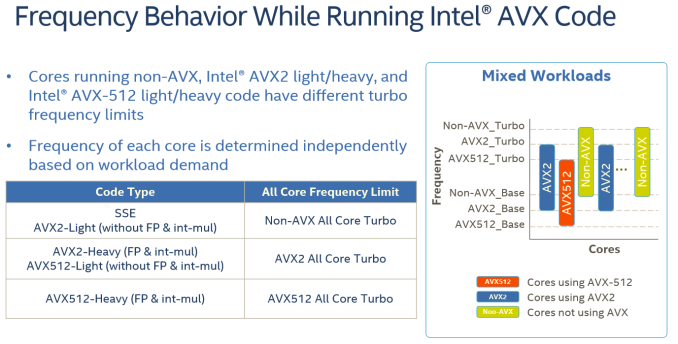Sizing Up Servers: Intel's Skylake-SP Xeon versus AMD's EPYC 7000 - The Server CPU Battle of the Decade?
by Johan De Gelas & Ian Cutress on July 11, 2017 12:15 PM EST- Posted in
- CPUs
- AMD
- Intel
- Xeon
- Enterprise
- Skylake
- Zen
- Naples
- Skylake-SP
- EPYC
Introducing Skylake-SP: The Xeon Scalable Processor Family
The biggest news hitting the streets today comes from the Intel camp, where the company is launching their Skylake-SP based Xeon Scalable Processor family. As you have read in Ian's Skylake-X review, the new Skylake-SP core has been rather significantly altered and improved compared to it's little brother, the original Skylake-S. Three improvements are the most striking: Intel added 768 KB of per-core L2-cache, changed the way the L3-cache works while significantly shrinking its size, and added a second full-blown 512 bit AVX-512 unit.
On the defensive and not afraid to speak their mind about the competition, Intel likes to emphasize that AMD's Zen core has only two 128-bit FMACs, while Intel's Skylake-SP has two 256-bit FMACs and one 512-bit FMAC. The latter is only useable with AVX-512. On paper at least, it would look like AMD is at a massive disadvantage, as each 256-bit AVX 2.0 instruction can process twice as much data compared to AMD's 128-bit units. Once you use AVX-512 bit, Intel can potentially offer 32 Double Precision floating operations, or 4 times AMD's peak.
The reality, on the other hand, is that the complexity and novelty of the new AVX-512 ISA means that it will take a long time before most software will adopt it. The best results will be achieved on expensive HPC software. In that case, the vendor (like Ansys) will ask Intel engineers to do the heavy lifting: the software will get good AVX-512 support by the expensive process of manual optimization. Meanwhile, any software that heavily relies on Intel's well-optimized math kernel libraries should also see significant gains, as can be seen in the Linpack benchmark.
In this case, Intel is reporting 60% better performance with AVX-512 versus 256-bit AVX2.
For the rest of us mere mortals, it will take a while before compilers will be capable of producing AVX-512 code that is actually faster than the current AVX binaries. And when they do, the result will be probably be limited, as compilers still have trouble vectorizing code from scratch. Meanwhile it is important to note that even in the best-case scenario, some of the performance advantage will be negated by the significantly lower clock speeds (base and turbo) that Intel's AVX-512 units run at due to the sheer power demands of pushing so many FLOPS.
For example, the Xeon 8176 in this test can boost to 2.8 GHz when all cores are active. With AVX 2.0 this is reduced to 2.4 GHz (-14%), with AVX-512, the clock tumbles down to 1.9 GHz (another 20% lower). Assuming you can fill the full width of the AVX unit, each step still sees a significant performance improvement, but AVX2 to AVX-512 won't offer a full 2x performance improvement even with ideal code.
Lastly, about half of the major floating point intensive applications can be accelerated by GPUs. And many FP applications are (somewhat) limited by memory bandwidth. While those will still benefit from better AVX code, they will show diminishing returns as you move from 256-bit AVX to 512-bit AVX. So most FP applications will not achieve the kinds of gains we saw in the well-optimized Linpack binaries.













219 Comments
View All Comments
ddriver - Wednesday, July 12, 2017 - link
LOL, buthurt intel fanboy claims that the only unbiased benchmark in the review is THE MOST biased benchmark in the review, the one that was done entirely for the puprpose to help intel save face.Because if many core servers running 128 gigs of ram are primarily used to run 16 megabyte databases in the real world. That's right!
Beany2013 - Tuesday, July 11, 2017 - link
Sure, test against Ubuntu 17.04 if you only plan to have your server running till January. When it goes end of life. That's not a joke - non LTS Ubuntu released get nine months patches and that's it.https://wiki.ubuntu.com/Releases
16.04 is supported till 2021, it's what will be used in production by people who actually *buy* and *use* servers and as such it's a perfectly representative benchmark for people like me who are looking at dropping six figures on this level of hardware soon and want to see how it performs on...goodness, realistic workloads.
rahvin - Wednesday, July 12, 2017 - link
This is a silly argument. No one running these is going to be running bleeding edge software, compiling special kernels or putting optimizing compiler flags on anything. Enterprise runs on stable verified software and OS's. Your typical Enterprise Linux install is similar to RHEL 6 or 7 or it's variants (some are still running RHEL 5 with a 2.6 kernel!). Both RHEL6 and 7 have kernels that are 5+ years old and if you go with 6 it's closer to 10 year old.Enterprises don't run bleeding edge software or compile with aggressive flags, these things create regressions and difficult to trace bugs that cost time and lots of money. Your average enterprise is going to care about one thing, that's performance/watt running something like a LAMP stack or database on a standard vanilla distribution like RHEL. Any large enterprise is going to take a review like this and use it as data point when they buy a server and put a standard image on it and test their own workloads perf/watt.
Some of the enterprises who are more fault tolerant might run something as bleeding edge as an Ubuntu Server LTS release. This review is a fair review for the expected audience, yes every writer has a little bias but I'd dare you to find it in this article, because the fanboi's on both sides are complaining that indicates how fair the review is.
jjj - Tuesday, July 11, 2017 - link
Do remember that the future is chiplets, even for Intel.The 2 are approaching that a bit differently as AMD had more cost constrains so they went with a 4 cores CCX that can be reused in many different prods.
Highly doubt that AMD ever goes back to a very large die and it's not like Intel could do a monolithic 48 cores on 10nm this year or even next year and that would be even harder in a competitive market. Sure if they had a Cortex A75 like core and a lot less cache, that's another matter but they are so far behind in perf/mm2 that it's hard to even imagine that they can ever be that efficient.
coder543 - Tuesday, July 11, 2017 - link
Never heard the term "chiplet" before. I think AMD has adequately demonstrated the advantages (much higher yield -> lower cost, more than adequate performance), but I haven't heard Intel ever announce that they're planning to do this approach. After the embarrassment that they're experiencing now, maybe they will.Ian Cutress - Tuesday, July 11, 2017 - link
Look up Intel's EMIB. It's an obvious future for that route to take as process nodes get smaller.Threska - Saturday, July 22, 2017 - link
We may see their interposer (like used with their GPUs) technology being used.jeffsci - Tuesday, July 11, 2017 - link
Benchmarking NAMD with pre-compiled binaries is pretty silly. If you can't figure out how to compile it for each every processor of interest, you shouldn't be benchmarking it.CajunArson - Tuesday, July 11, 2017 - link
On top of all that, they couldn't even be bothered to download and install a (completely free) vanilla version that was released this year. Their version of NAMD 2.10 is from *2014*!http://www.ks.uiuc.edu/Development/Download/downlo...
tamalero - Tuesday, July 11, 2017 - link
Do high level servers update their versions constantly?I know that most of the critical stuff, only patch serious vulnerabilities and not update constantly to newer things just because they are available.